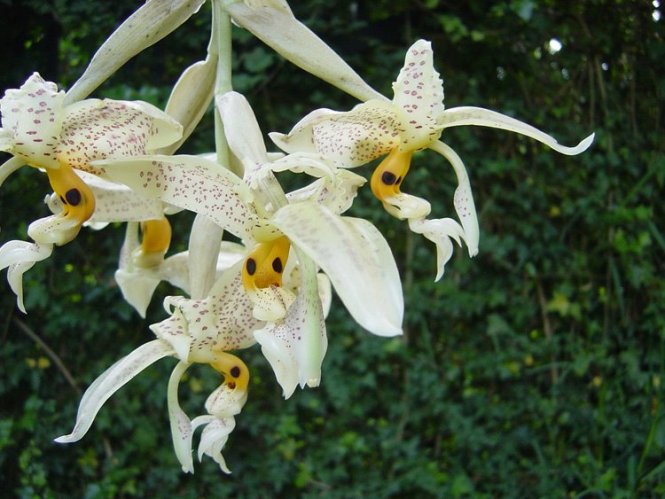Stanhopea is, without a doubt, one of our most beautiful wild orchids. There’s nothing quite like walking through a forest and spotting its yellow or cream-colored chandeliers of flowers hanging from a branch.
Because of their tree-dwelling habit, Stanhopeas do something only epiphytes can get away with: they shoot their flowers downward instead of upward or to the side. In the case of mature Stanhopeas, the result is a set of peculiar several-flowered inflorescences looking down on you from the branch of a tree. Since the flowers face the ground, when seen from the side they look asymmetrical and lack the particular orchid shape many of us are familiar with. They look more like massive winged insects.
The labellum (also called the lip) is the central petal in orchids and is usually shaped and/or colored differently from the rest of the petals and sepals. Along with many members of the Stanhopeniae subtribe, Stanhopeas possess an incredibly complex labellum. It is thick and waxy and much more solid than the rest of the flower, with its paper-thin petals and sepals. The Stanhopea labellum is made up of three parts: the basal hypochile, the central mesochile, and the apical epichile. The epichile often features a pair of “horns” whose presence or absence and shape help distinguish between species.
Stanhopeas are usually exceedingly fragrant, emitting scents that may travel great distances and still be easily distinguished by humans (and by insects from even further away). Nothing makes me smile like detecting a Stanhopea in bloom from over a hundred feet away by its mere scent. Certain species smell like chocolate, others like vanilla, and others have sweet fragrances that I find hard to describe. Each individual flower lasts only a few days before wilting, and each plant blooms only once a year. Such short-lived splendor attests to a kind of confidence expressed by the flower in attracting its specific pollinator and being successfully pollinated in a very short amount of time. In other words, they’re an evolutionary success.
Stanhopea taxonomy is often blurry – inexact at best. Certain species are easily identified while others form species pools that make it hard to distinguish where one species complex ends and another begins. The photograph shows one of the Stanhopeas in my back yard, most likely Stanhopea oculata.
~
La Stanhopea es, sin duda, una de nuestras orquídeas silvestres más bonitas. No hay nada como ir caminando en un bosque y ser sorprendido por su inflorescencia, una araña colgante de flores cremosas o amarillas anclada a la rama de un árbol.
Vivir sujetas a las ramas de los árboles le permite a las Stanhopeas hacer algo que solo las epífitas pueden hacer: sacar sus flores directamente hacia abajo, en vez de hacia arriba o hacia el lado. En una Stanhopea madura el resultado es una serie de curiosas inflorescencias de pocas flores, como lámparas colgando de la rama de un árbol. Ya que las flores se abren hacia el suelo, cuando se observan de lado aparentan ser asimétricas y carecen de la forma particular que mentalmente le asignamos a una orquídea. Más parecen unos enormes insectos voladores.
El labelo es el pétalo central en las orquídeas y generalmente tiene un color o una forma diferente al resto de los pétalos y sépalos. Junto con muchos miembros de la subtribu Stanhopeniae, las Stanhopeas poseen un labelo extremamente complejo. Es grueso y ceroso y mucho más sólido que el resto de la flor, con sus delicados pétalos y sépalos. Está compuesto de tres partes: la sección basal se llama hipoquilo, la central mesoquilo, y la apical epiquilo. El epiquilo a menudo tiene un par de “cachos” cuya presencia o ausencia y forma ayudan a distinguir entre especies.
Generalmente las Stanhopeas son desmedidamente fragantes, liberando un olor que puede viajar lejísimos y todavía ser detectado fácilmente por una persona. Nada me hace sonreír como percibir el olor de una Stanhopea a más de 50 metros de distancia. Algunas especies huelen a chocolate, otras a vainilla, y otras tienen fragancias dulces difíciles de describir. Cada flor dura solo unos días antes de marchitarse, y cada planta florece solamente una vez al año. Que sean tan efímeras es consecuencia de su seguridad de atraer a su polinizador específico y de ser polinizadas exitosamente en tan corto tiempo. Son un éxito evolutivo, en otras palabras.
La taxonomía del género Stanhopea es bastante inexacta. Algunas especies son identificadas fácilmente, mientras otras forman parte de complejos de especies en los cuales es difícil distinguir dónde termina una especie y comienza la otra. La fotografía muestra una de las Stanhopeas en mi jardín; es probablemente Stanhopea oculata.


Hey Challen! We met via Pueblo a Pueblo a couple of years ago. I stumbled across your blog accidentally while looking up info about an orchid. Just went to see a Stanhopea at the home of a friend yesterday – similar, but not identical to the one in your garden. Interestingly, I didn’t detect an aroma. Your blog is beautiful – thank you for sharing your gardening knowledge here! https://www.facebook.com/media/set/?set=a.10201889456583209.1073741832.1387484837&type=1&l=c8d0da76cf
Hello, Linda! Nice to read you around here! Thanks for the compliments! Stanhopeas are amazing. Some have stronger scents than others, and they only smell during the day (sometimes only at certain times of the day). Have a great day!